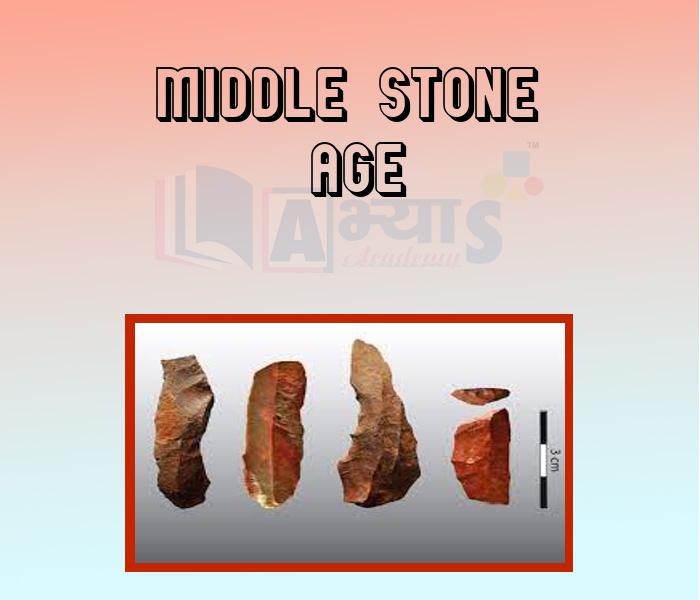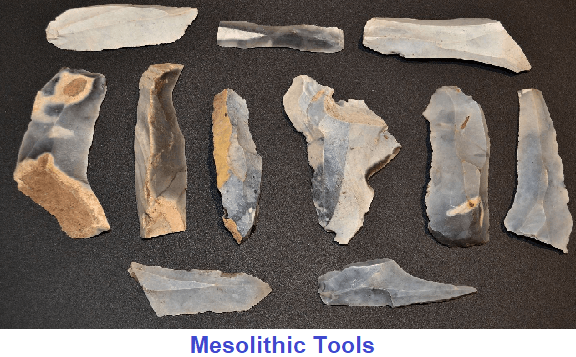Middle Stone Age

Middle Stone Age
Middle Stone Age
The Mesolithic Period, or Middle Stone Age, is an archaeological term describing specific cultures that fall between the Paleolithic and the Neolithic Periods. While the start and end dates of the Mesolithic Period vary by geographical region, it dated approximately from 10,000 BCE to 8,000 BCE.
The Paleolithic was an age of purely hunting and gathering, but toward the Mesolithic period the development of agriculture contributed to the rise of permanent settlements. The later Neolithic period is distinguished by the domestication of plants and animals. Some Mesolithic people continued with intensive hunting, while others practiced the initial stages of domestication. Some Mesolithic settlements were villages of huts , others walled cities.
The type of tool used is a distinguishing factor among these cultures. Mesolithic tools were generally composite devices manufactured with small chipped stone tools called microliths and retouched bladelets. The Paleolithic utilized more primitive stone treatments, and the Neolithic mainly used polished rather than chipped stone tools.
Art from this period reflects the change to a warmer climate and adaptation to a relatively sedentary lifestyle, population size, and consumption of plants—all evidence of the transition to agriculture and eventually the Neolithic period. Still, food was not always available everywhere, and Mesolithic populations were often forced to become migrating hunters and settle in rock shelters. It is difficult to find a unique type of artistic production during the Mesolithic Period, and art forms developed during the Upper Paleolithic (the latest period of the Paleolithic) were likely continued. These included cave paintings and engravings, small sculptural artifacts, and early architecture.


Name the linker period between New Stone Age and Old Stone Age ? | |||
| Right Option : B | |||
| View Explanation | |||
The rock shelters of the Middle Stone Age are found from the ____________________. | |||
| Right Option : A | |||
| View Explanation | |||
In the middle stone Age select the statement related to the tool type. | |||
| Right Option : D | |||
| View Explanation | |||
Students / Parents Reviews [10]
My experience was very good with Abhyas academy. I am studying here from 6th class and I am satisfied by its results in my life. I improved a lot here ahead of school syllabus.

Ayan Ghosh
8thMy experience with Abhyas is very good. I have learnt many things here like vedic maths and reasoning also. Teachers here first take our doubts and then there are assignments to verify our weak points.

Shivam Rana
7thAbhyas Methodology is very good. It is based on according to student and each child manages accordingly to its properly. Methodology has improved the abilities of students to shine them in future.

Manish Kumar
10thOne of the best institutes to develope a child interest in studies.Provides SST and English knowledge also unlike other institutes. Teachers are co operative and friendly online tests andPPT develope practical knowledge also.

Aman Kumar Shrivastava
10thIt has a great methodology. Students here can get analysis to their test quickly.We can learn easily through PPTs and the testing methods are good. We know that where we have to practice

Barkha Arora
10thBeing a parent, I saw my daughter improvement in her studies by seeing a good result in all day to day compititive exam TMO, NSO, IEO etc and as well as studies. I have got a fruitful result from my daughter.

Prisha Gupta
8thA marvelous experience with Abhyas. I am glad to share that my ward has achieved more than enough at the Ambala ABHYAS centre. Years have passed on and more and more he has gained. May the centre flourish and develop day by day by the grace of God.

Archit Segal
7thIt was good as the experience because as we had come here we had been improved in a such envirnment created here.Extra is taught which is beneficial for future.

Eshan Arora
8thMy experience with Abhyas academy is very good. I did not think that my every subject coming here will be so strong. The main thing is that the online tests had made me learn here more things.

Hiya Gupta
8thI have spent a wonderful time in Abhyas academy. It has made my reasoning more apt, English more stronger and Maths an interesting subject for me. It has given me a habbit of self studying









